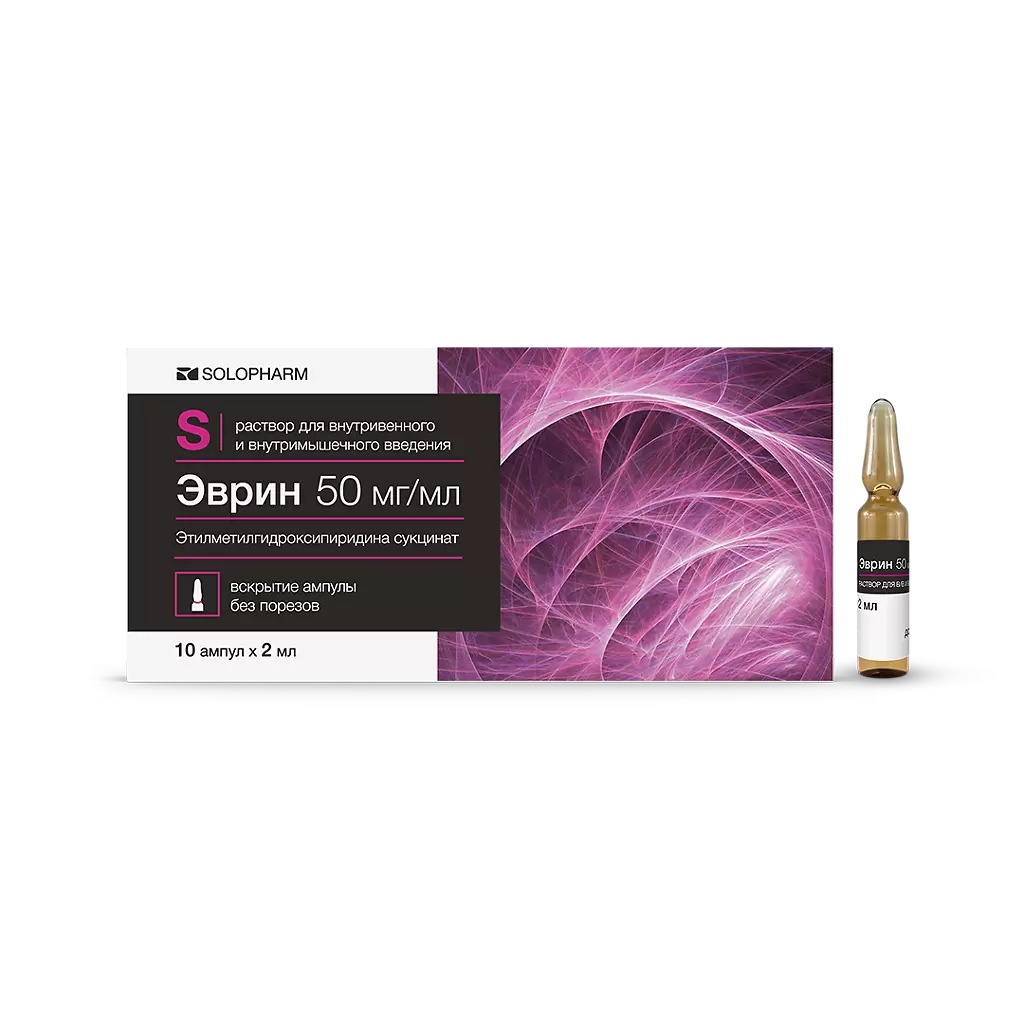No products in the cart.
Evrin, 50 mg/ml 2 ml 10 pcs
€12.36 €10.82
Description
An antioxidant agent.
ATX code:
N07XX.
Pharmacological properties
Pharmacodynamics
Ethylmethylhydroxypyridine succinate belongs to the class of 3-oxypyridines, is an inhibitor of free radical processes, membrane protector. It also has an antihypoxic effect and increases the body’s resistance to stress.
The mechanism of action of ethylmethylhydroxypyridine succinate is due to its antioxidant and membrane-protective action. The drug inhibits lipid peroxidation, increases the activity of superoxidoxidase, increases the ratio lipid-protein, improves the structure and function of cell membranes.
Ethylmethylhydroxypyridine succinate models the activity of membrane-bound enzymes (calcium-independent phosphodiesterase, adenylate cyclase, acetylcholinesterase), receptor complexes (benzodiazepine, gamma-aminobutyrate, acetylcholine), which increases their ability to bind to ligands, helps maintain the structural and functional organization of biomembranes, neurotransport and improve synaptic transmission.
Ethylmethylhydroxypyridine succinate increases the content of dopamine in the brain. It causes enhancement of compensatory activation of aerobic glycolysis and reduction of the degree of inhibition of oxidative processes in the Krebs cycle under hypoxia with increase of adenosine triphosphate (ATP) and creatine phosphate, activation of energy-synthesizing functions of mitochondria.
Enhances resistance of the body to various damaging factors in pathological conditions (hypoxia and ischemia, cerebral circulatory disorders, intoxication by ethanol and antipsychotic drugs).
In conditions of critical reduction of coronary blood flow promotes the preservation of structural and functional organization of cardiomyocyte membranes, stimulates the activity of membrane enzymes – phosphodiesterase, adenylate cyclase, acetylcholinesterase. Supports acetylcholinesterase activation that develops in acute ischemia.
Maintains activation of aerobic glycolysis developing in acute ischemia and promotes under hypoxia restoration of mitochondrial redox processes, increases ATP and creatine phosphate synthesis. Ensures the integrity of morphological structures and physiological functions of ischemic myocardium. Improves the clinical course of myocardial infarction, increases the effectiveness of therapy, reduces the incidence of arrhythmias and intracardiac conduction abnormalities.
Normalizes metabolic processes in ischemic myocardium, increases antianginal activity of nitrates, improves rheological properties of blood, reduces consequences of reperfusion syndrome in acute coronary failure.
It promotes the preservation of retinal ganglion cells and optic nerve fibers in progressive neuropathy caused by chronic ischemia and hypoxia. It improves the functional activity of the retina and the optic nerve, increasing visual acuity.
Limits enzymatic toxemia and endogenous intoxication in acute pancreatitis.
It improves metabolism and blood supply of the brain, microcirculation and rheological properties of the blood, reduces platelet aggregation.
Stabilizes blood cell membranes (erythrocytes and platelets), reducing the likelihood of hemolysis. It has a hypolipidemic effect by reducing the content of total cholesterol and low-density lipoproteins.
Pharmacokinetics
In absorption
In single and repeated administration the maximum concentration (Cmax) in plasma is reached after 0.58 h. When administered in dose of 400-500 mg the Cmax in plasma is 3.5-4 mcg/ml.
Distribution
It is rapidly distributed in organs and tissues. Average retention time of ethylmethylhydroxypyridine succinate in the body is 0.7-1.3 h.
Metabolism
Metabolized in the liver by glucuronidation. Five metabolites were identified: 3-oxypyridine phosphate – formed in the liver and with the help of alkaline phosphatase breaks down into phosphoric acid and 3-oxypyridine; the 2nd metabolite – pharmacologically active, formed in large amounts and found in the urine 1-2 days after administration; the 3rd – excreted in large amounts in the urine; the 4th and 5th – glucuronconjugates.
Elimation
Extracted from the blood plasma rapidly and practically undetectable after 4 hours in the blood plasma. It is rapidly excreted in the urine, mainly as metabolites (50% in 12 hours), and in a small amount – unchanged (0.3% in 12 hours). Rates of urinary excretion of unchanged ethylmethylhydroxypyridine succinate and metabolites have individual variability.
Indications
Indications
Active ingredient
Active ingredient
Composition
Composition
How to take, the dosage
How to take, the dosage
Interaction
Interaction
Special Instructions
Special Instructions
The drug is not prescribed to children under 18 years of age due to insufficient study of the drug action.
When using the drug, caution should be exercised while driving vehicles and engaging in other potentially dangerous activities requiring increased concentration and quick psychomotor reactions.
Contraindications
Contraindications
Allergic diseases in the history.
Side effects
Side effects
Overdose
Overdose
Pregnancy use
Pregnancy use
Similarities
Similarities
Additional information
| Shelf life | 3 years. Do not use after the expiration date! |
|---|---|
| Conditions of storage | In the consumer package at a temperature not exceeding 25 ° C. Keep out of reach of children. |
| Manufacturer | Grotex Ltd, Russia |
| Medication form | solution |
| Brand | Grotex Ltd |
Related products
Buy Evrin, 50 mg/ml 2 ml 10 pcs with delivery to USA, UK, Europe and over 120 other countries.
















